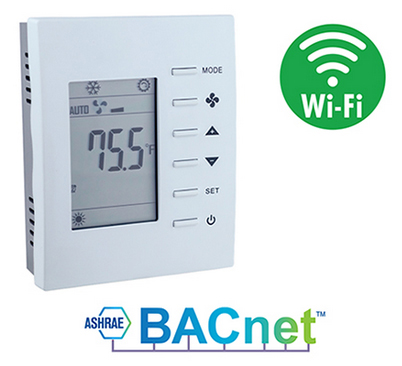Control Network Newsletter

BASstat Family Adds Humidity Sensing Models
 The BASstat family of BACnet-compliant wired or wireless communicating thermostats now offers two new models featuring a built-in relative humidity sensor which allow the thermostat to display relative humidity on the screen as well as serve as a BACnet object. Dew point calculation is also provided as a BACnet object, although no control action is taken based on humidity.
The BASstat family of BACnet-compliant wired or wireless communicating thermostats now offers two new models featuring a built-in relative humidity sensor which allow the thermostat to display relative humidity on the screen as well as serve as a BACnet object. Dew point calculation is also provided as a BACnet object, although no control action is taken based on humidity.
The two new models are available as follows:
- BAST-221CH-B2 BACnet MS/TP Thermostat 2-Heat/2-Cool/1-Fan/RH Wired
- BAST-221CH-BW2 BACnet/IP Thermostat 2-Heat/2-Cool/1-Fan/RH Wi-Fi
Everyone experiences personal discomfort when the humidity is too high. Your body reacts to heat and humidity. You sweat a lot – or more accurately your sweat evaporates more slowly so you end up hot and sweaty. While that alone isn't too alarming, high indoor humidity can have other serious adverse effects as well. Mold and mildew spores prosper in damp places and can cause a wide range of health issues and allergic reactions if they enter your body. Even if mold and mildew are not visible, they can hide in plain sight or behind walls. Hundreds of species of fungi and bacteria grow indoor in a humid environment. The most notable effects are allergies, asthma, and increased prevalence of respiratory symptoms. Certain types of fungi can even cause hypersensitivity diseases in healthy persons. Indoor pollution also causes perturbations of the immune system, making you more sensible to diseases. This is especially concerning in light of the current COVID-19 viral outbreak.
The most important trigger of microorganism growth is the amount of humidity in a structure. A thermostat with humidity sensing capabilities can combat this problem. With its effortless integration into BACnet/IP (Wi-Fi) or BACnet MS/TP (EIA-485) networks. These new thermostats are suited for single or multi-stage heating, cooling and ventilation binary output control applications such as RTU or AHU. Configurable control algorithm parameters allow adaptability to the specific application. Adaptive control algorithms applied to multi-stage on/off control saves energy and ensures seamless comfort for the occupants. A built-in (or remote input) temperature sensor, along with the built-in humidity sensor in the 221CH models allows for stand-alone operation with setpoints, reset and schedule from BACnet BMS or optional full BACnet BMS control. Occupancy status can be set from thermostat buttons or over the BACnet network. Thermostat buttons are optionally lockable to prevent unauthorized control. A digital display with graphical icons is easy to read and understand.
Visit the BASstat product page to learn more.